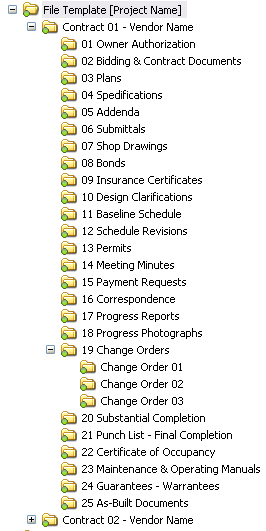Building Better Projects: The Function of Construction Document Management in Success
Building Better Projects: The Function of Construction Document Management in Success
Blog Article
Optimizing Task Partnership: Engineer's Finest Practices in Building And Construction Record Administration
In the complex realm of architectural projects, the reliable monitoring of building documents stands as a keystone for success. Architects, with their meticulous interest to detail and innovative style remedies, are charged with coordinating a harmony of sources, timelines, and stakeholders. In the middle of this complexity exists a vital concern: just how can architects simplify partnership processes to boost task end results? By exploring essential techniques such as leveraging cloud-based platforms, developing robust interaction methods, and ensuring data protection, architects can elevate their paper management methods to new heights.
Leveraging Cloud-Based Systems
By transitioning from standard paper-based systems to cloud services, designers can enhance collaboration, enhance record availability, and enhance overall project performance. This availability promotes smooth interaction and sychronisation amongst job stakeholders, leading to less mistakes and delays in the construction process.
Moreover, cloud-based systems offer a safe setting for saving sensitive job info, using encryption, routine backups, and customer consent setups to safeguard information honesty. Engineers can likewise profit from the scalability of cloud solutions, allowing them to change storage ability and capability based on job requirements. Generally, leveraging cloud-based systems empowers engineers to maximize their building file monitoring procedures, driving higher collaboration, effectiveness, and success in their projects.
Implementing Variation Control Systems
Having developed the benefits of cloud-based platforms in building paper administration, engineers can currently boost their paper control processes by applying Version Control Solution. Version Control Solution (VCS) are necessary tools that track changes in documents, making sure that staff member are always dealing with the most up to date and most exact information. By implementing VCS, designers can maintain a central database where all project papers are kept, allowing smooth partnership while minimizing the danger of mistakes and version problems.
This feature is specifically beneficial in building projects where layout models and alterations are common. This openness not only enhances responsibility however also aids in solving disputes or inconsistencies that may develop throughout the project lifecycle.
Developing Communication Methods
To guarantee efficient and efficient task coordination, architects need to develop clear and robust interaction procedures within their construction document administration procedures. Interaction methods specify the approaches, regularity, and networks where group participants exchange info, updates, and responses. One vital aspect of developing these procedures is identifying a central communication system where all project-related conversations and record sharing can occur. This system might be a task administration software, e-mail strings, or cloud-based storage remedies. By setting guidelines on how info is disseminated and how group members communicate with each other, architects can improve the circulation of information and stop miscommunications or hold-ups in the building and construction procedure.
Furthermore, interaction protocols ought to additionally consist of standards on how to handle conflicts, modification orders, and urgent concerns that may occur throughout the project lifecycle. Establishing an organized technique to communication ensures that all stakeholders are on the very same web page, advertises openness, and eventually adds to the effective completion of the building task.
Using BIM Software Program for Sychronisation
BIM software program plays a pivotal duty in improving sychronisation among task staff member in the construction market. Building Info Modeling (BIM) helps with partnership by providing a centralized system where architects, designers, service providers, and other stakeholders can collaborate in a worked with way. Through BIM software, task participants can access and upgrade a common design which contains comprehensive details concerning the structure design, building and construction elements, and task routines.

Additionally, BIM software program makes it possible for real-time cooperation and communication among staff member, despite their physical place. With cloud-based BIM systems, project stakeholders can access the most recent job information, track adjustments, and make notified choices promptly. Generally, leveraging BIM software program for sychronisation boosts project effectiveness, efficiency, and inevitably results in successful job results.
Ensuring Information Security and Conformity
In the world of construction record management, guarding data stability and making sure regulative conformity are vital factors to consider for architects and various other task stakeholders. Architects have to apply durable security actions to protect sensitive project info from unauthorized accessibility or violations. Using secure cloud storage options with security methods and accessibility controls can assist mitigate threats linked with information burglary or loss. Regularly upgrading software application and systems, carrying out protection audits, and giving personnel training on information security finest techniques are vital steps in maintaining a safe and secure environment for construction paper management.

Conclusion
In verdict, designers can maximize project collaboration in building document administration by leveraging cloud-based platforms, executing variation control systems, establishing interaction procedures, utilizing BIM software for control, and making certain information safety and security and conformity. These ideal methods assist streamline the building and construction procedure, enhance communication amongst task stakeholders, and improve effectiveness in task shipment. By adhering to these guidelines, architects can properly manage building records and help with successful job end results.
With BIM software program, project participants can access and upgrade a common design that contains in-depth info about the building design, building and construction parts, and task timetables.
Through cloud-based BIM systems, project stakeholders can access the latest job information, track modifications, and make notified choices promptly - construction document management. Generally, leveraging BIM software application for control improves task effectiveness, efficiency, and eventually leads to effective project results
In verdict, designers can optimize project cooperation in building document administration by leveraging cloud-based systems, implementing version control systems, establishing interaction protocols, utilizing BIM software for sychronisation, and guaranteeing data safety and compliance. These finest practices assist improve the construction process, boost interaction among task stakeholders, and enhance performance in task delivery.
Report this page